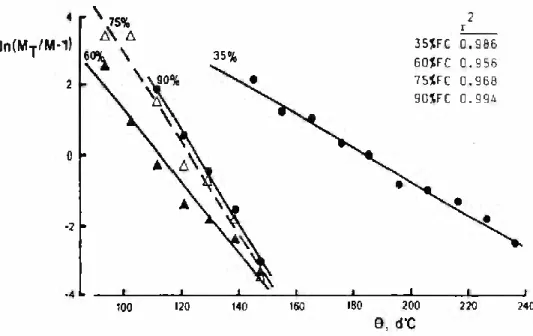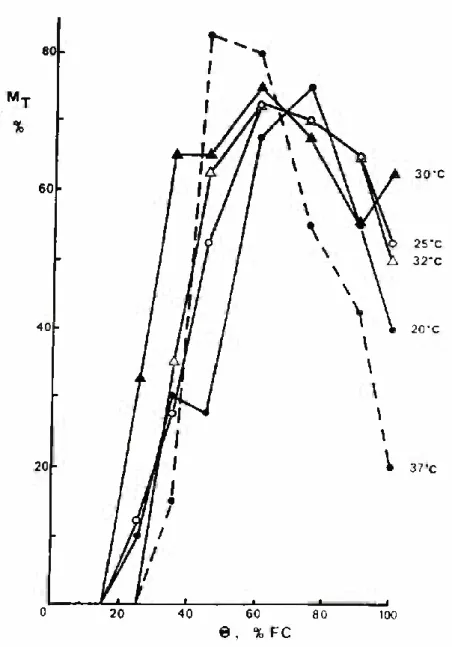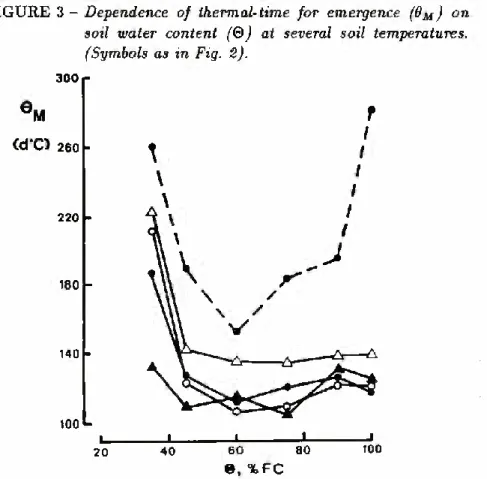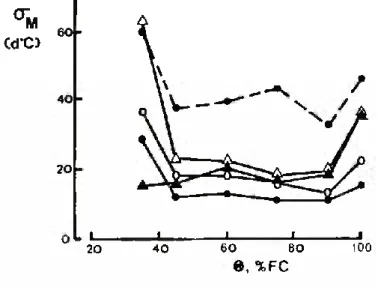Recebido em 22 de Dezembro de 1992
Groundnut seedling emergence
in relation to thermal-time and soil water
by
FRANCISCO G. ABREU
Professor Auxiliar, Agrometeorologia e Climatologia, Depart. de Ciências do Ambiente, Instituto Superior de Agronomia
and J.A. CLARK
Sénior lecturer, Environmental Science,
Depart. of Physiology & Environmental Science, Univ. of Nottingham
RESUMO
A medição do efeito de várias combinações de temperatura e água do solo sobre a emergência do amendoim permite verificar que as curvas de emergência relativamente à acumulação de temperatura são bem descritas por funções logísticas que se interpretam como curvas de probabilidade acumulada. Tais curvas permitem determinar facilmente o tempo-térmico para 50% da emergên cia final, a dispersão da emergência e a duração-térmica para ocorrência duma emergência de 80% da final.
Verifica-se que estes parâmetros são praticamente invariantes (relativa- mente ao tempo, à temperatura e à água) para teores de água no solo superi ores a 45% da capacidade de campo e temperaturas inferiores à óptima para a emergência, pelo que a sua medição pontual é representativa para toda esta gama de condições ambientais.
RÉSUMÉ
Les courbes d’émergence des cacahouètes en fonction du temps-thermique et du contenu en eau du sol sont analysées en utilisant une equation logis- tique interprétée comme une courbe sigmoide de probabilité cumulative. Cette equation decrit bien la variation de Témergencc cumulative en fonction du temps-thermique et est utilisée pour estimer la tiux d’émergence, 1’étalement de 1’émergence et le temps-thermique de 1’émergcnce sur le terrain.
Le concept de 1’invariabilité du temps-thermique pour 50% d’émergence finale, de 1’étalement de 1’émergence et de la durée d’émergence sur le terrain est démontré pour une vaste gamme de températures ambiantes et de contenus en eau du sol.
SYNOPSIS
Einergence curves of groundnut in respect of thermal-time and soil water content are analysed using a logistic equation inttrpreted as a sigmoid curve of cumulative probability. This equation describes well the thermal-time course of cumulative emergence and is used to estimate the speed of emergence, the spread of emergence and the thermal-time for fie:d emergence.
It is shown that the concepts ofan unique thermal-time for 50% final emer gence, the spread of emergence and the thermal-duration of field emergence are applicable over a large range of soil water content s and ambient temperatures.
1. INTRODUCTION
Seedling emergence is the first stage in successful crop esta- blishment and hence a major factor determining crop yield in the field. Consequently, agronomists are concerned with methods to evaluate emergence. Standard tests of seed viability and seed vigour are frequently used for this purpose. However, tests of seed viabi lity measure only the success of germinaiion (or emergence) at a single fixed set of conditions. Tests of seed vigour, although aimed to represent the behaviour of a seed lot in the field (Perry, 1981; Hampton and Coolbear, 1990), only assess the relative performance
of several lots and the information they provide can be further limi- ted by interactions between the rate and success of germination (see below). The specification of seed vigour has been reviewed recently
GROUNDNUT SEEDLING EMERGENCE 221
by Powell (1988) and Hampton and Cool3Ear (1990). However, a
method for evaluation of emergence performance in the field should give quantitative information on the three parameters of emergence which are significant factors in crop establishment: the “success” or size of the emerged population; the “speed” or rate of emergence; and the “spread” or duration of emergence (Janssen, 1973; Abreu,
1987). In addition, it should be reproducible over the wide range of soil water and temperature regimes which characterize the field environment.
Studies on the emergence and vigour of groundnut (Arachis hypogaea L.) in relation to the combined effects of soil temperature and soil water have emphasized the need for a method to describe fully the thermal-time course of emergence (abreu, 1987). Anal-
ysis of emergence in relation to thermal-time, rather than clock- time, enables the effects of soil water to be separated from those of temperature (Garcia-Huidobro, 1982; Abreu, 1987). Application of
the thermal-time concept to emergence has been based on the sin gle measurement of the thermal-time for emergence, defined as the temperature accumulated above the base temperature (for germina- tion) from sowing to 50% emergence of seeds sown (Feddes, 1971; An
gus, Cunningham, Moncur and Mackenzie, 1981; Garcia-Huidobro, Monteith and Squire, 1982; Mohamed, 1984). However, this neglects
information on the size of the emerged population and, particularly, on the spread of emergence in time. In addition, the use of 50% of seeds sown results both in the neglect of values of final emergence of less than 50%, which present useful information on treatment ef fects (Scott, Jones and Williams, 1984), and exaggerates slow rates
of emergence. When studying the emergence responses of a culti var across its complete range of tolerance, a better indicator of the speed of emergence is the thermal-time for emergence of half of the emerged population, SM (d°C). Hsu and Nelson (1986) and Muen-
del (1986) have used the same criterion to define the clock-time for
emergence.
Fitting curves to emergence data is useful to provide informa tion on the emergence parameters: time (and rate), spread and cumulative emergence (Janssen, 1973; Bould and Abrol, 1981; Hsu, Nelson and Chow, 1984; Scott et al., 1984; Brown and Mayer, 1988).
The several types of equations used for analysis of germination and emergence data have been reviewed by Scottet al. (1984) and Brown
the growth of populations, have been applied successfully to stu- dies of seed germination in relation to clock-time - eg. by Janssen
(1973), Schimpf, Flint and Palmblad (1977), Hsu et al. (1984) - and
have also been used in the analysis of seedling emergence (eg. Hsu
and Nelson, 1986). The statistical and bioiogical reasoning suppor- ting the use of logistic equations was discussed by Janssen (1973),
Schimpf et al. (1977) and Hsu et al. (1984).
Surprisingly, a limited amount of woik has been published on the combined action of soil water and temperature on emergence. This paper deals with the analysis of emergence curves of groundnut in respect of thermal-time and soil water using a logistic equation. The function employed assumes that the time distribution of emer gence presents a bell-shaped probability function in thermal-time, peaking at Emergence data were measured for combinations of soil water and soil temperature representing the realistic range encountered in the field, so that the effects of soil water on both the thermal-time for emergence and the spread of emergence could be estimated from the logistic data fitted e,t diíferent. temperatures. 2
2. MATERIAL AND METHODS
EMERGENCE DATA
The data analysed in this paper are the results of measure- ments of emergence of groundnut seedlings (cv. Kadiri 3) described by Abreu (1987). Briefly, measurements of emergence were made
on a temperature controlled propagation-bench, under ten soil wa ter contents (from 5% to 100% field capacity, FC) for each of five constant soil temperatures (20°C, 25.4°C, 30°C, 32°C and 36.9°C).
At field capacity the gravimetric water content of the sandy-loam soil used was 25.3 g water per 100 g oven-dried soil; the dry soil bulk density was 1.43 tm-3, similar to that in situ. Seeds were sown 5 cm deep and 10 cm apart in aluminium boxes filled with soil and housed in the bench. Forty seeds were used for each tempera ture/water combination. Emergence was counted three times a day until the experiments ended at the third consecutive day without progression on the records.
GROUNDNUT SEEDLING EMER3ENCE 223
DATA ANALYSIS
Emergence data were analysed on the assumption that the “instantaneous” thermal-rates of emergence dM/dO, with units % (d°C)-1, are well described by an equation similar to that discussed by Causton (1977),
dM/dO = kM( 1 - M/Mt) (1) where M (%) is the cumulative emergence at the accumulated ther- mal-time 9 (d°C), Mt is the final emergence and k, with units of (d°C)_1, is an empirically derived constant representing the re- lative thermal-rate of emergence and related to the spread of emer gence (see below). Equation 1 can be considered to define a bell- -shaped probability function which is symmetrical about the thermal-time at which the corresponding rate of emergence is a maximum. It follows that when 9 = Bm-, d2M/d92 = 0 and dM/d9 = kMx/4;. 9m is the mean (or most probable) thermal-time for emer gence - the thermal-time when seedlings are emerging with greatest frequency under the prevailing environmental conditions. In addi- tion to the description of the “instantaneous” emergence thermal- rates, Eq. 1 provides a simple way to quaníify the speed, the spread and the size of emergence at different elapsed thermal-times.
The integration of Eq. 1 with respect to 9 produces the logistic function
M = MtK 1 + bexp(-kO)) (2) where 6 is an empirically derived constant. Equation 2 can be considered as a sigmoid curve of cumulative probability, similar in shape to the integrated normal function, which describes the thermal-time course of cumulative emergence. Theoretically, the asymptotes are M = 0 when 9 = — oo and M = Mt when 9 = +oo. The inflexion point of this logistic equation is (9m, Mr/2), where 9m represents the thermal-time required for cumulative emergence to be half of the final emergence, rather than half of the seeds
sown. It can be shown that 9m = (ln b)/k. When Mt is known, the constants b and k can be obtained by a linear regression of ln(Mt/M— 1) on 0, since the linearizing transformation of Eq. 2 is
\n(MT/M — 1) = —k9 +ln b (3) The distribution of dM/d9 also provides information on the spread of the thermal-times of emergence around the mean. The
two inflexion points of dM/dO = f(0), calculated as d3M/d03 = 0, occur when
0 = 6
m i (ln(2 +Vs))/k
(4)At these points dM/dO = kMr/6- By analogy with the normal distribution, the quantity (ln(2-f \/3))/fc can be interpreted as equi- valent of the “standard deviation” and is a convenient measure of the spread of emergence ()•
The integral of dM/d.O between particular values of thermal- -tiine predicts the corresponding fractions of final emergence, while the total area under the dM/dO curve is Mt- This area may be considered as unity if M is normalized as M/Mj - The area of
dM/dO between the two inflexion points is
/ dM/dO • dO (5)
and equals 0.577 Mt , compared with 0.683 between ± one Standard deviation either side of the mean in the normal distribution. There- fore, the fastest emerging 60% of the final population (from about 0.2 Mt to 0.8 Mj) will emerge in a thermal-time of 2(ln(2 + y/3))/k.
A useful criterion for “Field Emergence” (Muendel, 1986) is a stand
of about 80% of the final density; this is reached at an elapsed thermal-time (08o) equal to Om plus one “standard deviation”, since
i
dM/dO-dO = 0.79 Mt (6)
3. RESULTS
For assessment of the Standard of fit of the logistic assumption, Eq. 3 was fitted to each emergence curve of groundnut. Represen- tative results are shown in Fig. 1 for emergence at 20°C on the propagation bench. For all experiments the goodness of fit was al- ways better than the 1% significance levei (in 80% of the cases at 0.1%), showing that the logistic assumption offers a good descrip- tion of cumulative emergence.
GROUNDNUT SEEDLING EMERGENCE 225 FIGURE 1 - Logarithmic transformation of the logistic fittings to
the thermal-time course (0, d°C) of cumulative emer- gence (M, %), at 20°C and gravimetric soil water con- tents of 35%, 60%, 75% and 90% field capacity. MT is the final emergence. Also shown are the coeficients of determination (r2) of each Une.
The final emergence was strongly affected by both soil water content and temperature, as shown in Fig. 2. The best final emer gence (70% to 80% of seeds sown) at each temperature occurred in a range of soil water contents from 45% to 75% FC, with high tem- peratures shifting the best Mj values towards the dry end of this range. For higher and lower soil water contents, the final emergence decreased to values frequently below 50% of seeds sown. Reduced fi nal emergence in “too” dry and “too” wet soils has been reported in the literature for other crops, particularly vegetable crops (Doneen and MacGillivray, 1943; Feddes, 1971). Figure 2 also shows that for
temperatures below the optimum for groundnut emergence, which is about 30-32°C (Abreu, 1987), the dependence of Mj on soil water
content above 50-60% FC was practically independent of tempera ture.
FIGURE 2 - The relationship between final emergence (MT, % of seeds sown) and gravimetric soil water content (Q, % of field capacity, FC) at the soil temperatures shown.
o 40 60
©, % FC 80
—i 100
GROUNDNUT SEEDLING EMERGENCE 227 Figure 3 shows the dependence of the estimated thermal-times for emergence on soil water content. For temperatures below the optimum, Om was independent of both soil temperature and soil water for contents above 45% FC. In these conditions, Om averaged 122 d°C with a Standard deviation of 11 d°C. The base temperature used for the calculations was 10.5°C, obtained by Mohamed (1984)
for germination of the same cultivar. However, increased to almost double the above value in drier soil. These results are similar to those reported by Feddes (1971) for emergence of radish, garden
beet, spinach and broad-beans, by Garcia-Huidobro(1982) for pearl
millet and by Rao and Dao (1987) for emergence of five Brassica
cultivars at a soil temperature of 7.5°C and five soil water potentials from — lOkPa to — 500 kPa. At 37°C, the thermal-times required for emergence of groundnut in wet soil were also much higher than those for temperatures below the optimum.
FIGURE 3 - Dependence of thermal-time for emergence (dM) on soil water content (Q) at several soil temperatures. (Symbols as in Fig. 2). 300 Cd‘C) 260 ■ 220 180 140 -100 L
r
i \ i 60 _J_________ I 80 e, % fc 20 40 100As indicated previously (Eq. 4), the spread of emergence was estimated for each M(6) curve as (ln(2 — \/3))/k, the “standard deviation” of the distribution of dM/dO with 6. The dependence of this quantity on soil water content and temperature is shown in Fig. 4. For temperatures below the optimum and soil water contents between 45% FC and 90% FC, <Jm was similar for all treat- ments, with a mean value of 17 ± 4 d°C. However, the spread of emergence increased to about 2.5 times this value at 37°C. For soil water contents outside the range 45% to 90% FC aM was larger in dry than in wet soils, except. at 30°C.
FIGURE 4 - Dependence of spread of emergence (aM, in thermal- -time units) on soil water content (0) at several soil temperatures. (Symbols as in Fig. 2).
M Cd'C) 60 -40 -20 -O*- 20 40 60 80 100 %FC
The combined effects of temperature and soil water content on the thermal-times for “field emergence” (Eq. 6) can be derived from Figs. 3 and 4, since #80 is the summation of corresponding values of 0\j and <7m- In praticai terms, for temperatures below the optimum and soil water contents between about 45% and 90% FC,
O80 can be considered almost independent. of both temperature and water, with a value of about 140 d°C. Drier soils and above optimum temperatures increase #80 sharply.
GROUNDNUT SEEDLING EMERGENCE 229 4. DISCUSSION
The thermal-time course of cumulative emergence of groundnut is well described by a logistic type equation of cumulative probabil- ity, the parameters of which can be used to characterize emergence. In particular, the final emergence, the thermal-time to emergence, the spread of the emergence thermal-times and the thermal-time for “field emergence” are easily obtained from such equations. This approach has two additional advantages: it can accomodate mea- surements with a final emergence below 50% of seeds sown, so that valuable information on treatments efiects is not discarded, and it avoids confounding survival with vigour.
There are reports in the literature of the use of several types of equations to describe the time course of seedling development, mainly germination, but none have been used for analysis of the thermal-time requirements. For example, Janssen (1973) and Schim-
pf et al. (1977) used a logistic-type approach to analyse the germi
nation of Veromca arvensis L., and Setana lutescens (Weigel) and
Amaranthus retroflexus L. in chronological time. Hsu et al. (1984)
also used a logistic equation to develop a model for germination of Sorghastrum nutans L., which was then applied successfully to the emergence of the same cultivar in the field (Hsu and Nelson,
1986). Their model assummed that the instantaneous rates of ger mination (and emergence) at each temperature were approximately normally distributed in clock-time, peaking at the time required for
50% emergence of seeds sown. In contrast, equations which accomo- date skewed data were used by Milthorpe and Moorby (1979) and
discussed by Brown and Mayer (1988), since germination is some-
times positively skewed (Nichols and Heydecker, 1968; Scott et al.,
1984; Brown and Mayer, 1988). However, most of the skew equations make the simplifying assumption that the instantaneous germina tion rate decreases continuously with time, from a maximum at the time germination starts. This may be realistic for fast germinating seeds, particularly at temperatures close to their optimum (Scottet
al., 1984), but Schimpf et al. (1977) considered a logistic function of
the type used in the present work a good fit for both fast and slowly germinating seed populations. There seems no reason to suppose that a particular type of skewness is a consistent characteristic of either germination (Goodchild and Walker, 1971) or seedling emer gence (Orchard, 1977). In addition, emergence is a longer process
than germination, particularly with large seeds like groundnut, and is subject to a wider range of environmental constraints. Since there is no reason to believe that the emergence curves should be of any particular shape, logistic functions appear appropriate where they are a good fit to the data.
Analysis of emergence curves in relation to thermal-time, rather than clock-time, allows the eífects of temperature on emergence to be decoupled from those of other environmental factors, as used by
Garcia-Huidobro (1982) and Squire and Ong (1983) to uncouple the
effects of temperature and water on emergence and leaf extension of pearl millet. In addition, use of thermal-time allows analysis of emergence in conditions of fluctuating temperature, when the use of clock-time is very difficult (Brown and Mayer, 1988).
A further advantage of the use of thermal-time is shown by the results presented in Figs. 3 and 4. The concepts of an unique thermal-time for 50% final emergence, the spread of emergence and the duration of field emergence are applicable over most of the range of soil water contents and ambient temperatures. For example, the measurement of these three parameters at a soil water content of 60-75% FC is adequate to characterize the behaviour of groundnut emergence in relation to time, temperature and water for tempera tures below 30-32°C and soil water contents above 45% FC. Assum- ing an average temperature of 27.5° C, half of the viable seeds will emerge in about 7 days after sowing, while field emergence will take one more day. Consequently, the final emergence as a proportion of seeds sown (%) and the thermal-time for field emergence (80% of final emergence) may provide useful parameters to characterize seed performance in the field.
ACKNOWLEDGEMENTS
This work was carried out at the Department of Physiology and Environmental Science of the University of Nottinham (UK), and the Microclimatology Group for Tropical Agriculture (Overseas Development Administration Microclimatology Unit, UK) based at the same University. We thank Prof. J.L. Monteith for his encour- agement of the work. F.G.A. also thanks the “Instituto Nacional de Investigação Científica” (Portugal) and the British Council (UK) for finantial support.
GROUNDNUT SEEDLING EMERGENCE 231 REFERENCES
Abreu, F.G. (1987) — Influence of Atmospheric Saturation Déficit
on Early Growth of Groundnut, Ph. D. Thesis, University of Nottingham, UK.
Angus, J.F., Cunningham, R.B., Moncur, M.W. and MacKen-
ZIE, D.H. (1981) — Phasic development in field crops. 1. Ther- mal response in the seedling phase, Field Crops Research, 3: 365-378.
Bould, A. and Abrol, B.K. (1981) — A model for seed germination
curves, Seed Science and Technology, 9: 601-611.
Brown, R.F. and Mayer, D.G. (1988) — Representing cumulative
germination. 2. The use of the Weibull function and other empirically derived curves, Annals of Botany, 61: 127-138.
CAUSTON, D.R. (1977) — A Biologista Mathematics, Edward Arnold.
Doneen, L.D. and MacGillivray, J.H. (1943) — Germination (emer-
gence) of vegetable seed as affected by different soil moisture conditions, Plant Physioloy, 18: 524-529.
Feddes, R.A. (1971) — Water, heat and crop growth, Meded. Landb. Wageningen, 71: 1-184.
Garcia-Huidobro, J. (1982) — Control by Temperature and Soil Wa
ter of Germination and Emergence in Pearl Millet, Ph. D. The sis, University of Nottingham, UK.
Garcia-Huidobro, J., Monteith, J.L. and Squire, G.R. (1982) —
Time, temperature and germination of pearl millet (Pennise- tum typhoides S. & H.). 1. Constant temperature, Journal of
Experimental Botany, 33: 288-296.
Goodchild, N.A. and Walker, M.G. (1971) — A method of mea-
suring seed germination in physiological studies, Annals of Bo tany, 35: 615-621.
Hampton, J.G. and Coolbear, P. (1990) — Potential versus actual
seed performance - can vigour testing provide an answer? Seed Science & Technology, 18: 215-228.
Hsu, F.H. and Nelson, C.J. (1986) — Planting date effects on seedling
development of perennial warm-season forage grasses. 1. Field emergence, Agronomy Journal, 78: 33-38.
Hsu, F.H., Netson, C.J. and Chow, W.S. (1984) — A mathemat-
ical model to utilize the logistic function in germination and seedling growth, Journal of Experimental Botany, 35: 1629- -1640.
Janssen, J.G.M. (1973) — A method of recording germination curves,
Annals of Botany, 37: 705-708.
Milthorpe, F.L. and Moorby, J. (1979) — An Introduction to Crop Physiology, Cambridge University Press.
Mohamed, H. A. (1984) — Varietal Differences in the Temperature Res ponses of Germination and Crop Esiablishment, Ph. D. Thesis, University of Nottingham, UK.
Muendel, H.-H. (1986) — Emergence and vigor of soybean in rela-
tion to initial seed moisture and soil temperature, Agronomy Journal, 78: 765-769.
Nichols, M.A. and Heydeker, W. (1968) — Two approaches to
the study of germination data, Proceedings of the International Seed Testing Association, 33: 531-540.
Orchard, T.J. (1977) — Estimating the parameters of plant seedling
emergence, Seed Science & Technology, 5: 61-69.
PERRY, D.A. (1981) — Handbook of Vigour Test Methods, International
Seed Testing Association, Zurich, Switzerland.
Powell, A. A. (1988) — Seed vigour and field establishment, Advances in Research and Technology of Seeds, 11: 29-61.
Rao, S.C. and Dao, T.H. (1987) — Soil water effects on low-tempera-
ture seedling emergence of five Brassica cultivars, Agronomy Journal, 79: 517-519.
Schimpf, D.J., Flint, S.D. and Palmblad, I.G. (1977) — Represen-
tation of germination curves with the logistic function, Annals of Botany, 41: 1357-1360.
Scott, S.J., Jones, R.A. and Williams, W.A. (1984) — Review of
data analysis methods for seed germination, Crop Science, 24: 1192-1199.
Squire, G.R. and Ong, C.K. (1983) — Response to saturation déficit
of leaf extension in a stand of pearl millet (Pennisetum ty- phoides S. & H.). 1. Interaction with temperature, Jounal of Experimental Botany, 34: 846-855.



